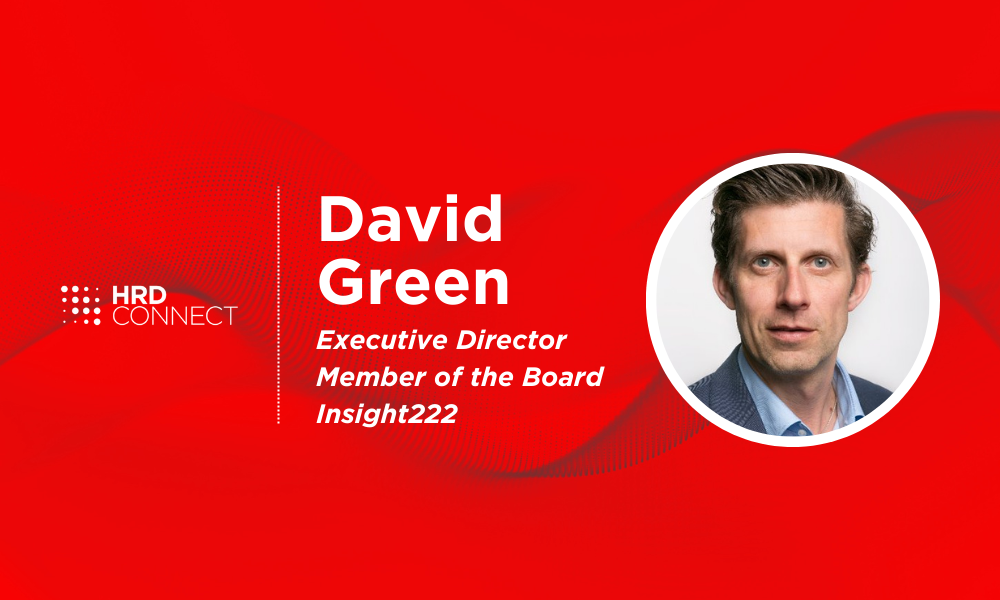Data democratization: David Green on upskilling HR to become data-driven
- 8 Min Read
David Green shares the best practices for data-driven HR, from communities of practice to data literacy, interpretation, and storytelling
- Author: Benjamin Broomfield
- Date published: Apr 6, 2023
- Categories

Leading organizations create value with people analytics. Democratizing data, upskilling HR professionals, and change management are all vital parts of building a data-driven culture in HR that add value across the business.
From creating a community of practice that celebrates successes and addresses data analytics challenges, to training HR business partners on data literacy, interpretation, and storytelling, David Green examines the steps organizations can take to convert insights from people analytics into measurable organizational outcomes. In this Q&A we learn how organizations can join the ranks of Microsoft, IBM, and Merck as industry-recognized leaders in embedding people analytics within the workforce.
1) You recently studied the characteristics of leading companies in people analytics. What did you find?
David Green: We’re constantly asked about what the best companies are doing. From the 184 companies we surveyed as part of our latest People Analytics Trends research, we found that leading companies have three common practices: Investing in their stakeholders and team, measuring the value of people analytics solutions, and scaling people analytics across the enterprise.
These break down even further to include steps like the CHRO mandating people analytics as a part of people strategy and developing data literacy skills among HR professionals, especially HR business partners. Moreover, the CHRO and their leadership team model the behavior from the top. They demonstrate that they are data literate. They use data in their communications with HR professionals and the wider business.
2) Let’s focus on building a data-driven culture in HR? Why is this important?
David Green: As Piyush Mathur, Vice-President of Human Resources at Johnson & Johnson said to me, ‘Insight without outcomes is overhead.’ If you don’t measure the outcomes from your insights, then you don’t know how effective or not it is.
It’s not just about building an effective people analytics team. It’s about focusing that people analytics team on the biggest business problems within the organization and trying to provide insights around people that can solve those problems. Part of that is around scaling and supporting HR professionals. Help them become more comfortable in using some of these insights from data in their discussions. It helps them to identify business challenges that people analytics can solve, but also pick out insights and drive them into measurable actions.
90% of the 184 companies said that the CHRO made it clear that data analysis is part of an essential strategy. But only 42% of those same companies said they currently have a data-driven culture for HR. So, the reality is very different from the CHRO’s mandate. Often, the responsibility falls on people analytics leaders. They have the responsibility of helping their colleagues in HR acquire skills in areas like data literacy, visualization and storytelling. By communicating their insights and making them widely available, people start seeing the benefit of people analytics and why it’s important.
3) What steps should an organization take to build a data-driven culture in HR?
David Green: Our research found there are three key elements to building a data-driven culture and sustaining it . Firstly, investing in the people analytics function. Invest in the team and their skills, but also in building or buying specialized technology to roll data insights out through ‘product ideation.’ In other words, scaling people analytics across the organization using technology.
Secondly, delivering value to the business. Measure and calculate return on investment. This should be a two-way conversation with stakeholders. Communicate the value of people analytics and data-driven HR across the organization.
Thirdly, embedding data-driven decision-making in three ways. Democratizing data, upskilling HR professionals (particularly HR business partners) in skills such as data literacy, data interpretation, and storytelling, and, supporting change management in HR.
4) What guidance can you share on how companies successfully democratize data to support decisions by leaders and managers?
David Green: Invest in accessible and easy-to-use tools. Get key sponsorship from the CHRO. Have a clear vision and mandate. Democratizing data is giving people the right information at the right time to support decisions. So, firstly, clarify the key business challenges or questions that people are typically trying to solve. For example, attrition. Democratize that data down to the manager level to help them understand how they compare with the rest of the organization, or how they compare with six or twelve months ago. Are they trending up or down? How do they compare to the external market?
Also, partner with data privacy to understand who can have access to this information at what level. When you’re equipping managers or HR business partners in different countries, ensure you’re not contravening data privacy legislation.
Consider developing a community of practice where people outside of the people analytics team can share successes and challenges, weekly, monthly, or quarterly. It could be HR business partners, those working in COEs, or even line managers. If you’ve got a good community of practice with speakers coming from inside and outside the business, you can create a thirst and interest for people data. Build the community as you go. Launching a community of upskilling goes beyond merely giving people access to dashboards and data. It helps HR professionals upskill and drives behavior change.
Lastly, a good way of measuring impact from the perspective of the people analytics team is to ask: Are we getting better questions or requests about the data? Are the requests more analytical questions or hypotheses for us to test rather than, ‘can we have this data’? When you see more sophisticated questions, it’s a positive sign that people are engaging more with the data.
5) What about upskilling HR professionals? What are the actual skills required, and how are companies supporting this need?
David Green: We’ve found there are several core areas where HR professionals want to upskill and become more data-driven. Firstly, how to drive more business value through people analytics and workforce planning. This requires developing analytical thinking, including how to build a hypothesis, techniques to get to the ‘real’ question, and data analysis and interpretation.
Leaders and professionals also want to upskill in human-centered design, UX, and digital literacy. This covers how to co-create and personalize HR programs and products with employees and take a user-centered approach to adoption. For example, how to understand and measure the moments that matter across the employee lifecycle.
Lastly, there are business-focused skills. These include consulting and influencing skills to develop stronger stakeholder relations, problem definition, and storytelling. This helps HR professionals to think about their audience, tell stories with data, drive action, and have the business acumen to tie this work back to organizational goals.
6) You highlighted change management as an important component. Please can you explain more?
David Green: The challenge with people analytics or any new domain in HR is employee experience. It’s not just about implementing technology, bringing people in with the right skills, or even upskilling. It’s about navigating a change in the way people act.
This means we need to change how we deliver HR, coming from the top. The HR team and HR leaders must embody the data-driven approach themselves. The best organizations celebrate the people in their teams who exhibit this cultural change and visibly acknowledge them.
You also want to make it a requirement for certain jobs within HR. Invest in the technology, create communities of practice, and communicate the value of data-driven HR. This drives more investment from the business. But it also helps HR professionals understand why it’s important both to the organization and to their careers. Think of people analytics as a catalyst to change the way people deliver HR across the organization.
7) Can you share any examples of companies that have successfully built a data-driven culture in HR?
David Green: Three companies spring to mind. Microsoft is a well-known example. Not only has Microsoft developed this culture itself, but its leadership team are sharing a lot of work that they’re doing. Dawn Klinghoffer has spoken about why Microsoft measures employee thriving not engagement, for example. When Microsoft changed CEO in 2015, there has been a widely documented cultural shift to focus on people data. Its people analytics teams have helped to do that thanks to investment in HR, upskilling, and clear buy-in and storytelling from leaders at Microsoft.
A good example of democratizing data is Merck Group. They invested in a people analytics tool, which they rolled out not just to HR professionals, but to the business. But more importantly, they created a community of practice with a team that met regularly. They’d work together to advocate for policies. But they also supported each other and shared stories on how data had helped them deliver more value to the business.
Lastly, IBM has been on a huge upskilling journey for its HR business partners going back to 2012. They’ve upskilled over 700 HR business partners. The CHRO was adamant this was expected from HR professionals. It provided them with the means to continually update their data and people analytics skills.
_______________
David Green is a globally respected writer, speaker, conference chair, and executive consultant on people analytics, data-driven HR, and the future of work. He works with HR practitioners and organizations to leverage analytical insights from employee data to drive business outcomes, increase performance and improve employee experience and well-being. You can hear his conversations with HR and People Analytics leaders from IBM, Microsoft, Johnson & Johnson, and Merck, on the Digital HR Leaders podcast.









